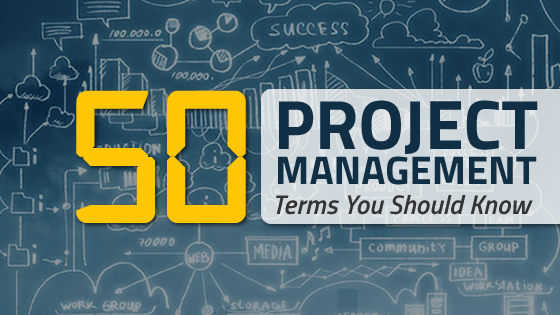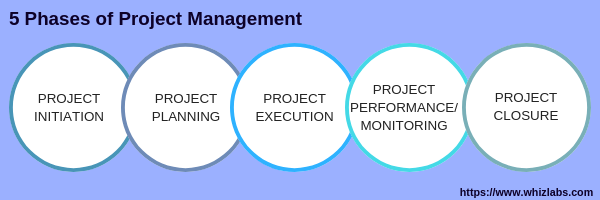Project management is a set of important skills for most of the careers. It is the application of processes, knowledge, skills, and experience to reach the project goal. Main components of project management are:
- Outlining the basis why a project is essential.
- Determining the project requirements, the standard of deliverables, resource allocation, timescales etc.
- Controlling risks, issues, changes in project and managing project budget as planned
- Providing communication with project team and stakeholders
- The closing of the project in a controlled manner at the proper time.
Also Read: Latest Project Management Trends in 2018
50 Project Management Terms You Should Know
Every course has its own glossary, and hence project management is not an exemption. Project Management glossary contains a number of project management terms that will help the project team to standardize the project’s startup process. These project management terms are the popular project management buzz words. Here we have given top 50 project management terms that you should know-
1. WBS (Work Breakdown Structure)
Work Breakdown Structure is one of the important project management terms. A work breakdown structure (WBS) is hierarchical that breaks down the work into manageable clods so that each level of WBS could be easily understood by the project team. Project team creates WBS by analyzing major deliverables and then dividing them into sub-deliverables. This dividing process is continued until it is assigned to a single person.
Do you know about communication methods in project management? If no, read the article – Communication methods and its importance in project management.
2. Milestone
A milestone is a scheduling process that describes the set of related deliverables. These are the significant points in time or an event that mark important moments during the project. This is a best practice for project managers to use a milestone in the project to celebrate something expressive being created. Milestone is one of the components of Gantt chart and you will be able to see them on the project schedules presented as a diamond. These are mainly used for
- Starting phase
- Ending phase
- Fixed dates on plan
3. Stakeholder
Stakeholders are very important in project management, thus stakeholder is one of the project management terms you should know. Stakeholders are the people engaged in and influenced by the project. Some of the stakeholders cover every section of the organization whether some have limited scope. Some of them are outsiders as government bodies. They must be informed about the necessary information. To deliver a product on the basis of customer’s demand is not enough for the success of a project. Projects must meet all the expectation of stakeholder.
4. Work Plan
One of the key terms of project management is its work plan. A work plan is an outline of a group of goals with the help of which project team can reach those goals. The aim of the project work plan is to promote efficiently, systematized and completion of the project according to budget, schedule, and requirements. It presents all the tasks involved in a project, who is responsible for each task and when these tasks will be completed. It includes the job scope, work product definition, task sequencing, budget, schedule etc.
5. Baseline
The baseline is one of the most popular project management terms among project managers. A baseline is used to measure the performance of the project. There are three baselines in project management. These are –
- Schedule baseline
- Cost baseline
- Scope baseline
The combination of these three is considered as complete performance measurement baseline.
6. Triple Constraint
All the projects are brought about under some constraints. Triple constraint is a four components group (time, scope, cost and quality of the product) represented by a triangle with time, scope and cost at corner side and quality at the central theme. There must a balance among all these components as the change in any one will impact the other components.

Still confused whether you should get certified in project management? Here is the answer if certification is required to grow in project management
7. Project Life Cycle
The project life cycle is among some important project management terms you should know. It includes project planning, analysis, design, implementation, and budget. A project life cycle can have many models but each model represents a single phase to build the deliverables of the project. A project life cycle consists of initiating the project, it’s planning, monitoring and controlling, executing, and closing.
8. Gantt Chart
Gantt chart is a bar chart that displays the scheduled information graphically. These are very useful in the planning and scheduling of the projects. It is also helpful in managing the relationship between tasks. This chart can be used to keep the project team and sponsors informed about the project progress. Using the Gantt chart, one will be able to see what is achieved by a certain date and, if the project is behind the schedule then an action can be taken to bring it on track.
9. Change Management
Change management is one of the project management buzz words. It is a project management plan that has authority to approve or reject the changes on the project. Purpose of this management is to manage the change that occurs during project according to the previous planned requirements and statements. If change management approves the new change in the project, only then the project manager will be able to modify the budget and deadline to reflect the additional work.
10. Risk Mitigation
At the beginning of the project, it is important to know the risk that surrounds the project because you can change your plan or can choose some other option to avoid the risk occurrence. And, risk mitigation is that project management term which identifies the risk. It is a risk reaction devising technique associated with menace to the project. If risks are not identified then it can cause a failed project by taking so much time as you are not prepared for that. So, this risk mitigation, risk identifying term is of much use as this idea reduces the possibility of occurring risk and also reduces the imprint of risk on the project.
11. Activity
During the course of a project, Work or Work Package consists of an Activity. Sometimes it is defined as the smallest part of a project. It identifies the timeline development, accurate estimating and many other aspects by turning into small tasks. Activity has a unique function i.e. sequencing. Along with Work Breakdown Structure (WBS), it states two main processes: Identification and Documentation.
12. Assumptions
While dealing with statement of work (SoW) and working on a project, Assumptions are listed as factors. It ensures the validation and result of projects. Assumption Analysis is a practice in which one can identify or calculate the accuracy part.
13. Agile
Agile is an approach particularly used for product and project management. Sprints are used in terms of short bursts of work typically in an iterative way to deliver software projects. Agile was initially developed for Engineering and Information Technology projects. But with the continuous innovation, marketing industry is also currently using it successfully. Agile’s approach is making its mark rapidly because it gives a flexible working style. It comes under the most popular project management terms.
Try: 25 Free Agile Certified Practitioner (PMI ACP)® Exam Questions with detailed Answers
14. Brainstorming
Before executing or designing a project, a complete SWOT analysis should have to be performed by teams involving in the same project. The technique used to calculate solutions, risks etc. by professionals is known as Brainstorming. It is basically an analysis method.
15. Business Case and Use Cases
Business Case is referred to a doc file which is used to store data like costs, calculations, benefits etc. Moreover Use Cases also help users by providing the requirement of software tests. These requirements are directed from end consumer directly. Use cases also concentrates on daily actions.
16. Business Plan
Business Plan is termed as a doc file which evidently describes about the project goals. It includes the business goals and their strategies to achieve them. Business Plan also concludes contextual info.
17. Certified Associate in Project Management (CAPM)
CAPM is generally found among the project management buzz words. Certified Associate in Project Management is an entry-level project management certification offered by Project Management Institute (PMI). This is a knowledge guide by the Project Management Institute to provide an associate level certification.
18. Contingency Plan
Contingency plan refers to the second plan if your plan A doesn’t work. It includes the situations which may or may not occur in future. Contingency plan provides solutions to exceptional risks. These risks have disastrous concerns. Thus it also includes the risks management. Contingency Plans are often designed by officials who are in businesses or Governments. It is sometimes referred to an alternative action.
19. Cost Estimation
Cost estimation is one of the most popular project management terms among project managers. Cost is the factor which is the most important for any business. It can impact profit and time duration of the project. So, cost estimating is the key method which is used to calculate entire project cost.
20. Critical Path Method (CPM)
Critical Path Method (CPM) provides functions to write an algorithm for project activities. It is particularly used for scheduling and termed as the “critical or shortest path”. Critical Path Method (CPM) is a step by step approach in which one can analyze critical and non-critical tasks.
21. Case Study
Case study comes among the important project management terms. Case Study is a process in which an individual or a team conducts a research on particular project to analyze its crucial aspects. It basically consists of document files consisting of approaches, practices, and product specifications.
22. Closing Processes
Closing Process is described as the termination of a project along with all the phases and processes. It is the end of the project that denotes the successful completion of the project. In the five steps of project management life cycle, closing process is the last step.
Also Read: 10 Steps at the Time of Project Closure
23. Dummy Activity
Before going through final activities, every project manager suggests dummy activities. Dummy Activities are shown with dashed lines. Dummy Activities are used after a failure, to describe that.
24. Dashboard
Dashboard is basically a platform which helps to check all the useful information about the project. Through dashboards, anyone can view data from their location. It is used to check KPIs where KPIs stands for Key Performance Indicators. Dashboard monitors all the reports and allows users to regularly update. Dashboards are categorized as Informational, Planned, Logical or Operational.
25. Deliverable
For every tasks or projects, there is a commitment of required result/output which is to be delivered to the users. That required output is known as deliverables. Deliverable is referred to perceptible or imperceptible objective which is the most important for a successful project. A document, A Report, End Product or Project Block are the best examples of Deliverables. It can be categorized in terms of Software, Hardware and design documents.
26. Earned Value & Earned Value Management (EVM)
Earned Value is termed as the methodology in which three main aspects of projects i.e. the actual work, project plan & value at which work is completed, are observed. It also demonstrates the timeline and total costs that have been spent on the projects. Moreover, Earned Value Management (EVM) is a process where one can schedule, measure, and check scope of performances.
Also Read: Earned Value Management – Analysis
27. Feasibility Study
Feasibility Study is among the most popular project management terms. It is defined as the process of assessment of a designed plan. It is a methodology in which you can see everything practicality. It consists of the activities like market research, polls, detailed project study etc.
28. Human Resource Planning
Human resource is responsible for the manpower and their deployment. In human resource planning, you can identify the individual roles. Also, you can observe the relationships between individuals who are related to the project.
29. Network Diagram
Network Diagram is a graph or chart which clearly indicates the flow of elements in the project. It also consists of the elements that are shown from left to right with their dependencies.
30. Organizational Breakdown Structure (OBS)
Organizational Breakdown Structure (OBS) is defined as the organization of a project in hierarchical depiction. It can rely on work packages to perform all the organizational activities.
31. PERT Chart
PERT Chart is used to evaluate the reviews. It is also known as Program Evaluation Review Technique. PERT Chart is used to create, establish, and organize tasks. A precedence diagram, a network chart, and logic diagram can be created in the PERT Chart.
Must Read: 25 PMP Formulas to Pass the PMP Certification Exam
32. PERT Estimate
PERT estimate is used to calculate time and costs. It is actually an accurate estimating technique. “Pessimistic plus the optimistic, plus four times the most likely, divided by six.” is the main formula used in PERT. PERT Estimate uses a prejudiced middling to expect the longevity of a task.
33. PRINCE2
PRINCE2 refers to Projects In Controlled Environments – version 2. It is a formal project approach which provides functions like Planning, Monitoring, and Controlling. It encourages individuals or teams to attain their goals timely. It also takes care of budget. It is also termed as a certification which is essential for UK and Europe project managers.
Preparing for PRINCE2 Foundation Certification? Get Certified Now.
34. Project Management Body of Knowledge (PMBOK)
PMBOK is one of the most popular project management terms among the project managers. Project Management Body of Knowledge (PMBOK) is a guide which concludes terms, best practices, strategies and procedures. This guide is a standard guide provided by The International Organization for Standardization and followed by the industry.
35. Project Management Professional
Project Management Professional indicates to an individual who is an expert professional. He/She is a certified project manager who is responsible for all the activities, elements, strategies etc. The category of certified project manager includes all the associate and professional level candidates.
What is the best strategy to prepare for PMP? Read here.
36. Project Change Request Form
Formalizes requests from anyone to the project manager. It requires the requestor not only to describe the change, but also to supply a reason why this change is appropriate and needed. Once the requestor has completed the form, the project manager can determine whether the change is indeed necessary, should be rejected, or should be delayed until the completion of the current project.
37. Project Management and Knowledge Area
An application consists of few key points: information, services, tools, and methods. These applications are defined by the Project Management Institute (PMI). Project Management also achieves the expectations of stakeholders. There is an area defined for project management for the knowledge requirements.
38. Project Manager
Project Manager is an individual who is responsible for a project . He/She is responsible for aspects like execution, planning, and closure of a project. There are various occupations like healthcare, information technology, architecture and others that requires Project Managers. No doubt, project manager is worth to be included in the list of top project management terms.
Also Check: What are the Responsibilities of a Project Manager?
39. Scrum
Scrum is an important approach in Agile. It is used for delivering software products with iterative incremental process. Scrum basically follows Rugby stint in which teams use short sprints. Short Sprints are useful for delivering a steady progress in a strong leadership. The leader in Short sprints is referred as Scrum Master.
40. Quality, Quality Assurance, and Quality Control
Quality is an interpretation which defines superiority and inferiority of things. Quality gives products’ sustainability, maintainability, and reliability. It also pre-decides the requirements which inherits characteristics. Quality Assurance refers to the approach which includes prevention of errors. It maintains the preferred level of the quality. Quality Control refers to the procedures which certifies that product defines the necessary goals.
41. Risk Management
In every project, you can have some risks. To reduce risks, there are few methods where you can manage risks. Also you can write down the potential risks occurred in the project and through the management tools, you can reduce them easily. Risk management is worth to be included in the list of top project management terms.
Are you preparing for PMI-RMP® Certification? Here’s the complete preparation guide for Risk Management (PMI-RMP)® certification exam?
42. Reporting
Reporting is an essential part in any project. Reporting is basically a document file in which every information about the project is stored with the development records. At every phase, one should report to the project manager so that every team which involves in the same project can gather.
43. RACI Chart
An RACI chart is defined as a matrix in which you can get all the significant actions happening in a project. It is bifurcated according to the roles or people. Also in matrix and at each intersection, you can allocate responsibility to anyone.
44. Resource Calendar
Resource calendar is termed as the list of working days along with non-working days which specifies the activity of resources. It is particularly used to calculate the holidays.
45. Statement of Work (SoW)
SoW stands for the Statement of Work. It describes the method and production of the project. It is basically a tool by which you can directly work with anyone. You just need to enter the description of tasks which is to be done.
46. Status Reports
Status reports deliver existing info on the project charge, financial plan, possibility, and other pertinent info. It also includes the completed tasks and tasks in future. It also includes a risk list and project duration.
47. SWOT Analysis
if you are in project management, SWOT analysis is among the project management terms you should know. SWOT stands for Strengths, Weaknesses, Opportunities and Threats. Before starting a project, there should be a SWOT analysis so that you can have all the required terms of the project and you can calculate the key terms. The SWOT analysis refers to the planning by which you calculate these terms.
48. Time Management
When a project is designed and delivered to the team for reference, then it consists of the time duration which every team should follow. It also indicates the method of scheduling and management of time of the project. It also involves the project manager, management and all the key personnels who are responsible for the project. It helps to calculate the team efficiency.
49. Three-Point Estimation
Three point estimation is a method or process by which you can take reviews or cases. Mainly known Three Point Estimations are best-case, worst-case, and most likely case. It helps enterprises to generate accuracy, calculate estimation, and average.
50. Waterfall Model
In Waterfall Model, There are various phases which need to be followed from sequentially one phase to the next. Waterfall Model is a traditional project management procedure in which sequential development process is followed. Also in this model, development actually moves in downward direction. It also consists of few phases like initiation, analysis, design, build, test, and maintenance. Besides, agile model is preferred over waterfall model now-a-days, waterfall model is always there in project management terms cheat sheet.
Final Thoughts
To deliver a project successfully, it is important to start the project with proper identification and pre-defined goal. For this, it is required to know and understand the project management terms. This article is the project management terms cheat sheet for those who are not familiar with the project management. Here, we have covered all the project management terms that you should know. So, give a good start to your project management career by reading these important project management terms.
You can also try PMP online course and PMP practice tests to prepare for the PMP certification exam.
- Top 20 Questions To Prepare For Certified Kubernetes Administrator Exam - August 16, 2024
- 10 AWS Services to Master for the AWS Developer Associate Exam - August 14, 2024
- Exam Tips for AWS Machine Learning Specialty Certification - August 7, 2024
- Best 15+ AWS Developer Associate hands-on labs in 2024 - July 24, 2024
- Containers vs Virtual Machines: Differences You Should Know - June 24, 2024
- Databricks Launched World’s Most Capable Large Language Model (LLM) - April 26, 2024
- What are the storage options available in Microsoft Azure? - March 14, 2024
- User’s Guide to Getting Started with Google Kubernetes Engine - March 1, 2024





Thank you!
🙂
Very good and detailed summary. I think it will be good to add the allocated or acquired work force competencies and abilities. Moreover the shot gun policies too.
Thank you
Informative…
Tag line @ Belief is powerful and thought of the day…
Can u please tell me what is CoC and COE in production scenario (COE: Center of Excellence)
Love your write up. Keep it up!
Thank you!
very clean definition. wonderful Neeru..
keep continue with same learning attitude
Well done !
Can you please share all the Abbreviations and acronyms used in Project management?
Thanks
Thanks.
What does PVT stand for in relation to Pre-commissioning test? What’s the V for..
Nicely done!
Concise n most effective terms described.. Tq
Great article!
I am a project manager (relatively new at that) at my company and as I’ve noticed besides of knowing the terminology it is also important to have a tool to work with.
We tried few until we ended up with Proggio.com
Easy to understand and simple to use. It has a free trial can be helpful especially for beginners to see how things work 🙂
I second Proggio recommendation
it is very friendly. They also have quick real people support that answered all my questions which is nice because in many places they use bots for that
Love your write up/ Keep writing for goodness! Many thanks
Thank You
Brilliantly added
Fantastic
Great Article. Thank you Neeru
Thanks1
Oh my goodness! Impressive article dude! Thanks
Very good write-up. I certainly appreciate this site. Keep it up!
great work and thanks for information.
Great article!! Thanks for sharing such article with us